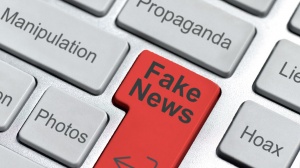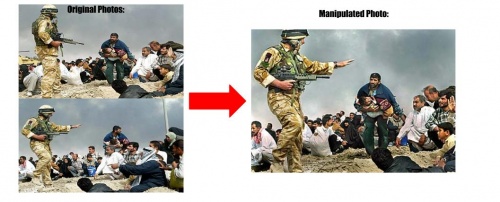Fake News
Fake News refers to incorrect information spread deliberately through various forms of news media, including print, broadcast, and social media that can be verified as false information. Fake news may be shared in the form of online or physical news articles that are constructed with the intent to mislead readers or articles from satirical sites which may be mistaken for actual news. [1] This term represents a fairly new development in the information age. Fake news is meant to cause social damage to a large entity or a famous individual, however the subject of fake news can be any person or thing. Historically, there have been many ethical issues involved in media platforms (i.e. yellow Journalism, sloppy journalism, etc.), but the emergence of social media and the subsequent rise of modern fake news has ushered into a new era of ethical concerns. Due to the ubiquity of social media, any and every single user could be a journalist in some shape or form as they can tweet or share news they believe is true yet its unreliable. Fake news is shared for a variety of reasons, ranging from discrediting a person or group of people to the potential monetary gain of a viral article.
Contents
Background
History
The earliest example of fake news can be traced back to a collection of six articles constructed by a reporter named Richard Adams Locke and released by the New York Sun in 1835.[1][2] The six articles, known as the "Great moon hoax", released by the New York Sun claimed to have scientific evidence of man-like creatures on the moon. It was declared as a hoax by a rival news paper named the Journal after Locke admitted to writing the story after hearing the Journal was in the works of reprinting the story.[2]
The first set of popularized fake news articles in modern mass media stems from a small town named Veles, Macedonia.[3] In a supposed get-rich-quick scheme, several companies in Veles paid teenagers to pump out falsified and sensationalized news articles to Facebook to gain advertising money. Thus a group of teenagers from Macedonia introduced fake news to the general U.S. public, writing many articles mainly centered around the 2016 U.S. presidential election because the exaggerated claims about Hillary Clinton or Donald Trump attracted high traffic. Stories such as "Pope Francis endorses Donald Trump" and "FBI Agent in Clinton email case found dead" went viral instantly. The Macedonians demonstrated financial gain from spreading intentionally deceitful internet articles about popular figure heads is possible, and this made fake news articles a staple in the mass media which spread rapidly across the world.
Fake news became popularized in the United States of America around the U.S. presidential election from late 2016 - early 2017 when the U.S. presidential candidates, Hillary Clinton and Donald Trump, began to use it in speeches and social media posts.[citation needed]
Variations
Fake news comes in many different forms. The easily identifiable types include:[4]
Click bait
Click bait is defined as stories that intentionally use a ridiculous headline to gain site views at the price of truth and actual content. Examples of click bait involve a famous person involved in an unthinkable act. For example, "Oprah exposed for lying to the world!"
Propaganda
Propaganda is intentionally writing a story with a biased perspective to achieve a goal.
Satirical fake
Satirical fake news is created with a focus on entertainment and comedy.
Sloppy Journalism
Sloppy Journalism occurs when the writer of an article or post uses unreliable sources containing fake news. They are at fault for not double-checking their sources.
Misleading headlines
Misleading headlines are similar to Click bait but with more substance within the article.
Biased News stories
Biased news stories are created to appeal to people's pre-existing beliefs. Unlike propaganda, these articles are written to gain attention not to shift beliefs.
Social Media
Social media provides a platform that allows people to spread false information because content is created by users. There is no overarching governing body checking facts, as most posts on social media are not fact-based anyway. Facebook and Twitter have received numerous complaints for not monitoring fake news on their sites[citation needed] . A study on Twitter showed that fake news stories were retweeted significantly more than real news, and it takes longer for real news to spread[5]. This is because it has been proven that people are more likely to share new, surprising information, which could contribute to the extensive spread of fake news. On Facebook, people’s news feed are comprised of the most popular posts, those that receive the most “likes,” and posts that are exaggerated or fake news tend to get many likes.[6] This feature increases the visibility of false information. Many people use social media as their only news source which leads to open access of consuming more rumors than factual news [5].
Ethical concerns
Accountability on Social Media
If a fake news story is spread around on Facebook, it is not necessarily Facebook's job to catch this inaccuracy and stop the circulation. After all, Facebook was created for people to share their own ideas, and its algorithms are designed to get people to spend as much time as possible on the site. If this means that fake news stories are going to keep people on the site longer, and Facebook is not accountable for detecting fake news, then this cycle will never end. If platforms are not willing to hold users accountable for creating real content, then the social norms on the site are the only defense left to govern what is spread online.
Mental and Physical Damage
Fake news is defined as information that intends on deceiving its audience. Regardless if the aim of a person or group spreading fake news is monetary or political gain, or any reason otherwise, this deceit is a problem as it may lead to further ethical concerns.
A notable example of one seeking personal entertainment through the reactions of others by writing fake news is shown in the case of Christopher Blair. Blair created his own satirical and politically right-winged Facebook page and titled it “America’s Last Line of Defense”. Blair published several articles a day, with each one making some ludicrous claim either promoting or demonizing a political figure.[7]
While Blair’s Facebook page displays a warning that the posts are not actually real, this warning may go unnoticed to many readers. A majority of Blair’s audience demographic is comprised of adults and the elderly, and many of them struggle to distinguish between real and fake news online. Information literacy has changed drastically in the Digital Age, as those who had "grown up "before the exponential growth in information access via the internet. Because of this it can easily persuade to them that most news reported are trustworthy due to its limited quality news sources and peer review. With the abundance of information online in the Digital Age, and the relative ease of publishing content, information literacy is an important skill those of all ages should acquire. Blair is not the only individual publishing fake news online, and vast amounts of writers may write and publish satirical content for personal gain.
Serious damage can occur because readers believe in the information and will most likely share the "news" and their peers will agree with the information as well. This realization can be difficult for the reader, as Harry Frankfurt notes: "When someone is lied to by a person they trust, it causes them to look inwards on their own decision making to see who they can trust."[8]. In other words, many people trust and believe that articles such as Blair's tell the truth, and when they're proven wrong, it can be difficult for them to believe any kind of news in the future.
Fake news can also lead to violent interactions in the real world. In 2016 the Pizza Gate scandal occurred. A man barged into a pizza shop in Washington D.C. with a rifle in order to free the child sex slaves that he believed were hidden in the basement.[9] The man fired several shots in the ceiling. While thankfully, no one was hurt, this incident occurred because the man truly believed a fake news article. Incidents of mental and even physical damage have chances of occurring as long as the readers of fake news truly believe in what they're reading.
Proving a point?
Fake news articles seem to gravitate around celebrities, as stories pertaining to popular individuals will gain more attention than one about George Johnson from Iowa. Justin Bieber has been a headline-worthy celebrity for quite some time, so a YouTube channel known as Yes Theory decided to do a "challenge", to see if they could get a fake news article -about Justin- to go viral. They decided they would hire a Justin Bieber look-a-like, dress him up to look even more the part, and have him do several infuriating, but harmless things around Los Angeles.[10] For example, they had the fake Bieber sit on a park bench and eat a Chipotle burrito from the middle instead of the ends as most people do. The group sent the photos to news editors and posted them online. Within 48 hours, the picture was trending on Twitter, Reddit, and was featured on several news channels. The Yes Theory crew had achieved their goal of seeing if they could trick the world. The picture was taken with the intent to deceive, but was done in a different sort of manner. The goal was to see if they could make something go viral. The extremity of the picture differs drastically from articles such as Blair's, a simple photo of a celebrity doing something weird as opposed to an article about a leading politician running a child-sex ring. However, reinforcing Frankfurt's point, lies can hurt people and it is possible that people will not be as willing to believe these kinds of posts when they see them next time. The news sites who reposted this photo may receive backlash due to their sloppy journalism. It is true that Justin Bieber is a celebrity but it does not allow people to falsify his identity.Misuse of Power
Sometimes fake news can be implemented in order to achieve personal gain. The appeal of personal achievement can drive credible news personnel to stretch the truth and misuse their position of power. In February 2003, Brian Walski -former photographer for the LA Times- submitted a photo from the ongoing Iraq War that was later found to be an alteration of two images brought together[11]. The image -pictured left- was briefly crowned as one of the most breathtaking photos from the war and would have expanded Walski's reputation as an accredited photographer, instead the opposite occurred. When people found out about Walski's rouse, the photo's crown was lost as well as Walski's reputation. Professional journalists and photographers are kept to a high ethical code and when this code is broken, it can be difficult to undo the damage and re-enter the spotlight. Brian Williams, former news anchor for NBC Nightly News, also spread fake news about the Iraq War in 2003. Back then, Williams was an on-the-scenes reporter covering the early stages of the war. One day he was riding in a US military helicopter when Williams said the helicopter was shot at and was experiencing difficulty keeping altitude due to the shots from the ground. Williams circulated this story and it was believed to be true until February, 2015. It was then revealed that Williams had lied about the bullets, fabricating a typical helicopter malfunction into gunshots.[11] Williams was subsequently fired from NBC and has been unable to re-enter the realm of news anchoring since the revelation of his fake encounter. As noted with the teenagers in Veles, Macedonia, monetary incentives drive fake news articles more effectively than anything else. Brian Walski and Brian Williams fabricated fake news surrounding the Iraq War in order to sell their media content and gain popularity within the world of journalism. In the end, the strong ethical code discerning fake news ended the careers of Brian Walski, Brian Williams, and numerous other journalists.
Future Concerns
Today, a good amount of people can identify fake news due to lack of useful evidence. However, this era of fake news may evolve into a new form in the near future as technology continue to advance itself. It is debated if software will be an option to enable users to create fake videos of people and potentially using that person's voice. Should this software be available? This would allow people the ability to create videos of celebrities executing odd or damaging things in order to sell the video to news sources. Thomas Kent argues this could even sway entire elections in the future if enough people believe the difficult-to-discredit videos.[12] Careers could potentially be ruined and credible journalism could take a major "blow" as sites would no longer distinguish the authenticity of videos. This can lead to a lack of trust in the news. According to Kent, it s prevalent that one take action soon rather than later, in whatever form if possible. He suggests passing laws to discourage the creation of these videos before its a problem.[13]
There are some progress being made in limiting fake news online. Facebook and WhatsApp are taking interest in these issues. Facebook believes that false news has been harmful to the community as it decreases trust and people are less informed on the topic(s). Their main focuses are disrupting economic incentives, build new products to stop fake news, and help people become more informed. [14] Facebook is not alone as Whatsup as its changing its policies to better limit fake news. Previously, one could forward a message up to 256 conversations at once but now one can only forward a message to five different chat conversations at once to limit informing others. [15] Its safe to say that people were putting forth the effort until something better came along. They were simply just trying to do their part with the resources they had.
Some of these concerns may come to fruition sooner than experts believe. There already exists a very powerful fake text AI known as Deep Fake Created by Open AI, Deep Fake is a text-generating bot that runs on 1.5 billion parameters while retrieving sample text from 40 gigabytes of top Reddit posts.[16] The text-bot then outputs text based around whatever is inputted into the model, responding with shockingly cohesive and comprehensible text. The OpenAI team quickly realized the potential of their creation to spread fake news across the internet at a whole new rate. They opted to keep the whole 1.5 billion parameter version to themselves and instead released a toned-down version of only 117 million parameters for users to play with.[16] OpenAI has the ability to realize the true potential of the bot, known as GPT-2. They decided to not make profit off their full version for the sake of internet safety and security. The released version, dubbed GPT-2 Junior, still contains several bugs, indicating the full version will most likely succeed. However, once the bugs are fixed, the junior version of the Deep Fake text bot could have the ability to spread fake news across every corner of the internet. The OpenAI team acknowledged that the bot could produce fake news anywhere from the Amazon review section to entire fake ebooks. The potential of bots such as GPT-2 is something to remain cautious on over the next few years as fake news increases in frequency and complexity.
References
- ↑ 1.0 1.1 Allcott, Hunt, and Matthew Gentzkow. 2017. "Social Media and Fake News in the 2016 Election." Journal of Economic Perspectives, 31 (2): 211-36.
- ↑ 2.0 2.1 Thornton, Brian. “The Moon Hoax: Debates About Ethics in 1835 New York Newspapers.” Journal of Mass Media Ethics, vol. 15, no. 2, 2000, pp. 89–100., doi:10.1207/s15327728jmme1502_3.
- ↑ Wendling, Mike. “The (Almost) Complete History of 'Fake News'.” BBC News, BBC, 22 Jan. 2018, www.bbc.com/news/blogs-trending-42724320.
- ↑ “Explained: What Is Fake News? | Social Media and Filter Bubbles.” Webwise.ie, 2 July 2018, www.webwise.ie/teachers/what-is-fake-news/.
- ↑ 5.0 5.1 “Want Something to Go Viral? Make It Fake News.” NBCNews.com, NBCUniversal News Group, www.nbcnews.com/health/health-news/fake-news-lies-spread-faster-social-media-truth-does-n854896.
- ↑ Odrozek, Kasia. “Spotlight: Understanding ‘Fake News.’” Mozilla, 25 May 2018, internethealthreport.org/2018/spotlight-understanding-fake-news/.
- ↑ Saslow, Eli. “'Nothing on This Page Is Real': How Lies Become Truth in Online America.” The Washington Post, WP Company, 17 Nov. 2018, www.washingtonpost.com/national/nothing-on-this-page-is-real-how-lies-become-truth-in-online-america/2018/11/17/edd44cc8-e85a-11e8-bbdb-72fdbf9d4fed_story.html.
- ↑ Frankfurt, Harry. “On Truth, Lies, and Bullshit.” The Philosophy of Deception, by Clancy W. Martin, Oxford University Press, 2009, pp. 43
- ↑ Tandoc, Edson C, et al. “Defining ‘Fake News.’” Digital Journalism, 30 Aug. 2017.
- ↑ Theory, Yes, director. We Fooled the Internet w/ Fake Justin Bieber Burrito Photo. YouTube, YouTube, 28 Oct. 2018, www.youtube.com/watch?v=Vs6In7UtyXY.
- ↑ 11.0 11.1 Carlson, Matt. “THE REALITY OF A FAKE IMAGE News Norms, Photojournalistic Craft, and Brian Walski's Fabricated Photograph.” Journalism Practice, vol. 3, no. 2, 2009, pp. 125–139., doi:10.1080/17512780802681140.
- ↑ Kent, Thomas. “Fake News Is about to Get so Much More Dangerous.” The Washington Post, WP Company, 6 Sept. 2018, www.washingtonpost.com/opinions/fake-news-is-about-to-get-so-much-more-dangerous/2018/09/06/3d7e4194-a1a6-11e8-83d2-70203b8d7b44_story.html?noredirect=on&utm_term=.bfe7ccd2ed17.
- ↑ Kent, Thomas. “Fake News Is about to Get so Much More Dangerous.” The Washington Post, WP Company, 6 Sept. 2018, www.washingtonpost.com/opinions/fake-news-is-about-to-get-so-much-more-dangerous/2018/09/06/3d7e4194-a1a6-11e8-83d2-70203b8d7b44_story.html?noredirect=on&utm_term=.bfe7ccd2ed17.
- ↑ “Working to Stop Misinformation and False News.” Working to Stop Misinformation and False News | Facebook Media, www.facebook.com/facebookmedia/blog/working-to-stop-misinformation-and-false-news.
- ↑ Wagner, Kurt, and Rani Molla. “WhatsApp Is Fighting Fake News by Limiting Its Virality. Could Facebook and Twitter Do the Same?” Recode, Recode, 25 Jan. 2019, www.recode.net/2019/1/25/18197002/whatsapp-message-limit-fake-news-facebook-twitter.
- ↑ 16.0 16.1 Gallagher, Sean. “Twenty Minutes into the Future with OpenAI's Deep Fake Text AI.” Ars Technica, 27 Feb. 2019, arstechnica.com/information-technology/2019/02/twenty-minutes-into-the-future-with-openais-deep-fake-text-ai/.



